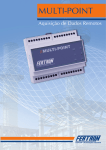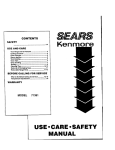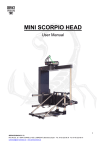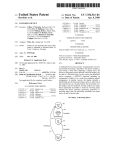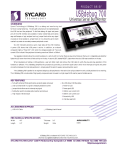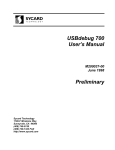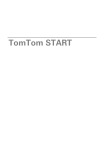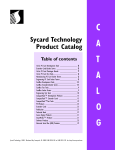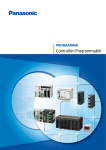Download Method and system for testing a universal serial bus within a
Transcript
USO0RE40541E (19) United States (12) Reissued Patent (10) Patent Number: US RE40,541 E (45) Date of Reissued Patent: Oct. 14, 2008 Korhonen (54) METHOD AND SYSTEM FOR TESTING A UNIVERSAL SERIAL BUS WITHIN A COMPUTING DEVICE (75) Inventor: Aki Korhonen, Reno, NV (US) OTHER PUBLICATIONS Archive of “Diagnostics Hardware and Software for PCT testing and repairiUltraiX. . .”www.uxd.com, [online][Ar chived by http://archive.org on Jun. 20, 2000; Retrieved on Mar. 23, 2006] Retrieved from the Internet<URL:http:// (73) Assignee: PC-Doctor, Inc., Reno, NV (US) web.archive.org/web/20000620000644/http://www.uxd. (21) App1.N0.: 11/600,688 Archive of “Diagnostics Hardware and Software for PCT testing and repairiUltraiX. . .” www.uxd.com, [online] com>. (22) Filed: [Archived by http://archive.org on Jun. 20, 2000; Retrieved Nov. 15, 2006 on Jul. 5, 2006] Retrieved from the Internet<URL:http:// web.archive.org/web/20000620000644/http://www.uxd. Related US. Patent Documents Reissue of: com>. (64) Patent No.: 6,829,726 Issued: Dec. 7, 2004 Appl. No.: 09/800,763 Filed: Mar. 6, 2001 (Continued) Primary ExamineriNadeem Iqbal (74) Attorney, Agent, or FirmiFenwick & West LLP US. Applications: (60) (57) Provisional application No. 60/187,317, ?led on Mar. 6, 2000. (51) (52) (58) Int. Cl. G06F 11/00 bus (“USB”) within a computing device. In an exemplary 714/27, 31, 4, 3, 56, 43; 710/5 See application ?le for complete search history. References Cited 5,859,993 A 1/1999 Snyder ..................... .. 712/208 10/2001 Larky et a1. 6,343,260 B1 1/2002 6,389,560 B1 6,393,588 B1 6,480,801 B2 5/2002 5/2002 11/2002 embodiment, the system includes a test device and a test control module. The test device is connected to a USB port on the computing device. The test control module resides on the computing device and interacts with the test device to test the USB port. Once connected, the test device is used to monitor signals on the USB port exchanged between the test device and the USB port. Examples of signals that are moni tored are the voltage levels, frame timing, and USB bus sig U.S. PATENT DOCUMENTS 6,311,294 B1 The present invention generally relates to the ?eld of testing computing devices. More speci?cally, the present invention relates to a system and method for testing a universal serial (2006.01) US. Cl. ............................................ .. 714/25; 710/5 Field of Classi?cation Search .................. .. 714/25, (56) ABSTRACT 714/44 Chew ........ .. .. 702/122 Chew .... .. Hsu et al. . Chew .... .. 714/43 .. 714/43 702/122 6,577,979 B1 6/2003 Okitaka 6,605,966 B1 8/2003 Chen et al. 702/117 6,701,401 B1 3/2004 Lu et a1. ....... .. 6,732,301 B1 5/2004 Landry et al. ............... .. 714/43 ..... .. 327/76 nals and power voltages. The test device then communicates the monitored information to the test control module for analysis. The test control module is further capable of caus ing a second set of tests to be performed including a ?lll speed device detect test, a bulk transfer test, an isochronous transfer test, an interrupt transfer test, and a low-speed device detect test. The results of these tests are then commu nicated to the user. .. 710/305 s1: uurrrrnne use 'Bsl dam-(a) In 27 Claims, 2 Drawing Sheets 59- use real progrnm communicate: wilh use real usvlea mderarmirre ran reaulu and sum“. USBPOYK!) s10: use lntdlvlce responds wllrr 52 use Iss1 device vel?es vullage current ran Mulls and marine: lmu, r adequate, valraga ox llgM In s11. use lest program pmhrms bulk rrarrsfer rm, parrmrllrrg large bulk s3 usersmns use use! program hinders to and mm are use lesl de'VlOe 54- ll needed. km program enables use commller and slans me use hus weer bus barrawm zllnmtlon occult s5: use ran wrrrrollaraarms Iss1 dsviw, Wpmeeni, pi?ormslulkspued devlee detect Iss1 s13: USEtestplvgrim parrarrrrs lararrupr narralar \Hil, verifying mar 56: use us! rim/Ice ls wn??ured aawramg \0 use pmml. Once eon?gumlicn ls wmplo'e. a mmplalls light is m (mlgm also be a change a! wlarror ma voltage OK llgm) mmpme a: pmper lnllrvals 5N: use lest program mquasls use \ slmulltes wapeea d evi we . use he! magnum veri?es rrlar low-speed 51: use les1devies marrlrnra use . . Si mulelionl'5 detected . m minimum and maximum valiarloe'lum speci?ed (ram: llrlglh. s15. Teal passes? learamerersmrmalw sa use an device monitors use bus siqnilarld powsrvnhlgu smm average, rrllnlmum and maximum levels Yes Na Tes?rlg complete. No snore delecled Rewn Errar US RE40,541 E Page 2 OTHER PUBLICATIONS Archive of “Hardware Diagnostic ToolsiUltraiX, Inc.,” WWW.uxd.com/hproducts. . ., [online] [Archived by http:// archive.org on Aug. 17, 2000; Retrieved on Mar. 23, 2006] Retrieved from the Internet<URL:http://Web.archive.org/ Web/20000817115611/WWW.uxd.com/hproducts. . .>. Email from Stuart Ting to Anoop Singh (Jun. 9, 2000) re NeWsiNeW Product Release4QuickTech USB, 2 pages. Email from Stuart Ting to Anoop Singh (Jul. 13, 2000) re ***NeW Release***iQuickTech USB Port Tester from UltraiX Inc., 2 pages. “NeWsiNeW Product Release4QuickTech USB,” Archive of “*** NeW Release*** iQuick Tech USB UltraiX, Inc., 2000, [Online] [Retrieved on Jul. 5, 2006] Tester,” WWW.uxd.com/qtu... , [online] [Archived by http:// neWs.html>. archive.org on Jan. 7, 2001; Retrieved Mar. 23, 2006] Retrieved from the Internet<URL:http://Web.archive.org/ Web/20010107145600/http://WWW.uxd.com/qtu...>. Archive of “Sycard Technology,” WWW,sycard.com, [online] [Archived by http://archive.org on Jun. 14, 1998; Retrieved on Jul. 27, 2006] Retrieved from the Intemet<URL:http:// Web.archive.org/Web/19980614222343/http://WWW.sycard. com/>. Archive of “TradeShowsiUltraiX, Inc.,” WWW.uxd.com/ tradeshowshtml [online] [Archived by http://archive.org on Nov. 21, 2000; retrieved on Jul. 5, 2006] Retrieved from the Internet<URL:http://Web.archive.org/Web/20001 121033 900/ uxd.com/tradeshoWs.html>. Archive of “Universal Serial Bus DebuggeriUSB Retrieved from the Internet<URL:http://WWW.uxd.com/ “PC Computer HardWare Diagnostic ToolsiUltraiX, Inc.,” Updated Apr. 7, 2001, [online] [retrieved on Mar. 23, 2006] Retrieved from the Internet<URL:http://WWW.uxd.com/ hproducts.htm>. “Product Brief: USBdebug 700, Universal Serial Bus Moni tor,” Sycard Technology, 1 page. “Professional PC Diagnostic Tool Kits,” UltraiX Incorpo rated, 8 pages. “Professional PC Diagnostic Tool Kits,” UX, 8 pages. “QuickTech USBipoort tester,” UltraiX Benelux, 1 page. “QuickTechiUSBTM User’s Guide,” UltraiX, Inc., 199842000, 11 pages. [Archived by http://archive.org on Jun. 14, 1998; Retrieved “Real World TechnologiesiUltraiX Quick Tech USB Tester, ” Real World Technologies, 199642001, [online] [Retrieved on Jun. 29, 2006] Retrieved from the Internet< on Jul. 27, 2006] Retrieved from the Intemet<http://Web. URL:http://WWW.realWorldtech.com/includes/templates/ archive.org/Web/19980614222531/WWW.sycard.com/usbde bug.html>. articles.cfm?ArticleID=RWT013001000000&mode...>. Archive of “Universal Serial Bus DebuggeriUSB Updated Aug. 9, 1999, [online] [Retrieved on Jul. 27, 2006] debug700,” debug700,” WWW.sycard,com/usbdebug.html, WWW.sycard.com/usbdebug.html, [online] [online] [Archived by http://archive.org on Dec. 7, 1998; Retrieved on Jul. 27, 2006] Retrieved from the Intemet<URL:http:// “Sycard TechnologyiUSB Products,” Sycard Technology, Retrieved from the Intemet<URL:http://WWW.sycard.com/ usb.html>. “Sycard Technology USBtest 2000 Universal Serial Port Web.archive.org/Web/19981207005128/WWW.sycard.com/ usbdebug.html>. Tester,” Sycard Technology, Updated Nov. 25, 2002, [on Archive of “Universal Serial Bus Port TesteriUSBtest Internet<URL:http://WWW.sycard.com/usbtest.html>. 2000,” WWW.scycard.com/usbtest.html, [online] [Archived by http://archive.org on Dec. 6, 1998; Retrieved on Jul. 27, 2006] Retrieved from the Intemet<URL:http://Web. archive.org/Web/ 1 998 1 206073754/WWW. sycard.com/usb test.html>. Archive of “WWW.sycard.com,” WWW.sycard.com/ index.html, [online] [Archived by http://archive.org on Dec. line] [Retrieved on Jul. 27, 2006] Retrieved from the “2001/Feb UltraiX marketing Guide,” UltraiX Incorpo rated, 8 pages. “UltraiX Launches QuickTech USB, USB Port and Hub Tester,” NeW Product Releases, Mar. 23, 2006, 2 pages. “+++USB Diagnosis made easy With QuickTech USB/Ul 5, 1998; Retrieved on Jul. 27, 2006] Retrieved from the traiX (UK) Ltd.,” Jun. 30, 2000, [online] [Retrieved on Jun. 15, 2006] Retrieved from the Internet<URL:http://comput Internet<URL:http://Web.archive.org/Web.archive.org/Web/ 19981205191905/http://WWW.sycard.com/index.html>. “USB Diagnosis made With easy With QuickTech USB,” “CATC Announces Industry’s First Production Test Tool for USB Hubs,” LeCroy Corporation, 2006, [online] [retrieved on Jul. 27, 2006] Retrieved from the Intemet<URL:http:// er.prarchive.com/en/pr35298.htm>. PRWeb, 199742006, [online] [Retrieved Jun. 15, 2006] Retrieved from the Intemet<URL:http://WWW.prWeb.com/ releases/2006/6/prWeb/15937.htm>. WWW.lecroy.com/Product/Press/CATCfArchive/O12400i UPT.asp?neWsiid=607&menuid=40>. “USBdebug 700 User’s Manual,” Sycard Technology, Jun. “CATC Announces Industry’s First Production Test Tool for USB Hubs,” Jan. 24, 2000, 2 pages. “USBdebug 700 User’s Manual,” Sycard Technology, Jun. 1998, 8 pages. 1998, 7 pages. “Win the race against doWntime! UltraiX Benelux is de “CATC Introduces The First USB/Ethernet Link,” Aug. 16, 1999, 3 pages. impor‘teur van PC Diagnose Tools,” UltraiX Benelux, 1 “CATCTM UPTTM Universal USB Port Tester User’s page. Manual,” Computer Access Technology Corporation, Sep. AnsWer to Complaint, May 24, 2006, PCiDoclor, Inc.v.Ul zraiX, Inc.(C.D. Cal.) (Case No. CV 0641729 GAF (Ex)). 22, 2000, 46 pages. “Comdex Guide Program & Exhibits Guide,” Fall 2000, Nov. 13417, 2000, 2 pages. Computer Service & Support, Sep./Oct. 2000, pp. 32433. “Dealer Info: Bedrijfspro?elen,” Aug. 18, 2000, 1 page. “Dealer Info: ProductnieuWs,” Aug. 18, 2000, 1 page. “Dealer Info: VlAiCyrixz comeiback van de budgetiCPU,” Aug. 18, 2000, 1 page. Memorandum of Points and Authorities in Support of UltraiX, Inc.’s Motion for Order Granting Leave to Amend AnsWer, Nov. 21, 2006, PCiDoclor, Inc.v. UllraiX, Inc. (CD. Cal) (Case No. CV 0641729 GAF (Ex)). Plaintiff PCiDoctor, Inc.’s Motion to Stay Proceedings, Nov, 30, 2006, PciDoclor, Inc.v. UllraiX, Inc. (CD. Cal.) (Case No. CV 0641729 GAF (Ex)). US RE40,541 E Page 3 Plaintiff PCiDoctor, lnc.’s Opposition to Defendant UltraiX’s Motion for Order Granting Leave to Amend Answer, and Counter Motion to Strike lnequitable Conduct Defense, Jan. 8, 2007, PCiDoclor, Inc. V. UllraiX, Inc. (CD. Cal.) (Case No. CV 06*l729 GAF (EX)). Memorandum of Points and Authorities in Opposition to Plaintiff PCiDoctor, lnc.’s Motion to Stay Proceedings, Jan. 8, 2007, PciDoclor, Inc.v. UllraiX, Inc.(C.D. Cal.) (Case No. CV 06*l729 GAF (Ex)). Plaintiff PCiDoctor, lnc’s Counter Motion to Strike lnequi table Conduct Defense, Jan. 8, 2007, PCiDoclor, Inc. V. Order Re: Plaintiff‘s Motion to Stay and Defendant’s Motion for Leave to Amend AnsWer, Jan. 31, 2007, PCiDoctor, Inc. v. UltraiX, Inc. (CD. Cal.) (Case No. CV 06*l729 GAF (Ex)). Declaration of Jonathan A. McMahon in Support of Defen dant UltraiX, lnc.’s Opposition to Plaintiff PCiDoctor, lnc.’s Motion to Stay Proceedings, Jan. 5, 2007, PCiDoclor, Inc.v. UlzraiX, Inc. (CD. Cal.) (Case No. CV 06*l 729 GAF (Ex)). Ultra X, Inc. (CD. Cal.) (Case No. CV 06*l729 GAF (Ex)). Reply in Support of Plaintiff PCiDoctor, lnc’s Motion to Deposition of Carmine Napolitano, Jan. 24, 2007, PCiDoc Stay Proceedings, Jan. 12, 2007, PCiDoclor, Inc.v. UllraiX, Inc.(C.D. Cal.) (Case No. CV 064729 GAF (Ex)). GAF (Ex)). Defendant UltraiX, lnc.’s Reply to Plaintiff PCiDoctor, lnc.’s Opposition to Motion for Order Granting Leave to Amend AnsWer and Opposition to Plaintiff” s Counter Motion to Strike lnequitable Conduct Defense, Jan. 12, 2007, PciDoclor, Inc. V. UllraiX, Inc. (CD. Cal.) (Case No. CV 06*l729 GAF (Ex)). Z01’, Inc. v. UllraiX, Inc. (CD. Cal.) (Case No. CV 06*l729 Deposition of Mike Mori, Sep. 18, 2006, PCiDoclor, Inc. v. UlzraiX, Inc. (CD. Cal.) (Case No. CV 06*l729 GAF (Ex)). Plaintiff PCiDoctor, lnc.’s Response to Defendant UltraiX, lnc’s First Set of Requests for Admission, Dec. 4, 2006, PCiDoclor, Inc.v. UllraiX, Inc.(C.D. Cal.) (Case No. CV 06*l729 GAF (Ex)). US. Patent 0a. 14, 2008 6m$:028: H Sheet 1 of2 .6253:0.2 3 I?ESQE O mtom: w.“ 2k [email protected] m6co8qwm .23 2 .NIN US RE40,541 E US. Patent C Oct. 14, 2008 Start l S1: User inserts USB test device(s) in Sheet 2 0f 2 US RE40,541 E S9: USB test program communicates with USB test device to determine test results and statistics. USB port(s). l l 810: USB test device responds with current test results and statistics. S2: USB test device veri?es voltage levels, if adequate, voltage OK light lit. l l 811'. USB test program performs bulk 83: User starts USB test program. transfers to and from the USB test device. transfer test, performing large bulk l 84: If needed, test program enables USB controller and starts the USB bus. l l 812: USB test program performs isochronous transfer test, verifying that proper bus bandwidth allocation occurs. S5: USB host controller detects test device, if present, performs full-speed l device detect test. 813: USB test program performs l S6: USB test device is configured according to USB protocol. Once con?guration is complete, a complete light is lit (might also be a change of color for the voltage OK light). interrupt transfer test, verifying that interrupt transfers complete at proper intervals. l l 814'. USB test program requests USB test device to perform low-speed USB device detect test. USB device simulates low-speed device. USB test program verifies that low-speed 87: USB test device monitors USB simulation is detected. frame timing. Stores average, minimum and maximum variance from specified frame length. 815: Test passes? ll parameters normal? l 88: USB test device monitors USB bus signal and power voltages. Stores average, minimum and maximum levels. Yes V No ( Testing complete. No errors detected. } C FIG. 2 Report Error DH US RE40,541 E 1 2 METHOD AND SYSTEM FOR TESTING A UNIVERSAL SERIAL BUS WITHIN A COMPUTING DEVICE erated by protocol analyzers requires considerable skills to decipher. Moreover, protocol analyzers are generally very cumbersome and bulky. Additionally, they are not economi cal or feasible for the general public or individual consumer to own. Thus, a person outside of the design environment will generally not have access to a testing device to deter mine if a USB host controller, a USB cable, and/or a USB Matter enclosed in heavy brackets [ ] appears in the original patent but forms no part of this reissue speci?ca tion; matter printed in italics indicates the additions made by reissue. port are working properly. Protocol analyzers are not designed for users to test if these features are not working; but rather, for a designer to use in the development of a CROSS-REFERENCES TO RELATED APPLICATION(S) USB-supported device. The present application claims the bene?t of priority under 35 U.S.C. § 119 from the provisional patent application, US. patent application Ser. No. 60/187,317, ?led on Mar. 6, 2000, which is hereby incorporated by refer Furthermore, a typical scenario in which a user of a com puting device needs to troubleshoot the USB is when a USB device is plugged in and yet not detected by the computing device. The problem may lie with the USB device, the USB ence as if set forth in full in this document. cable, the USB port or the USB host controller. Under this type of con?guration, troubleshooting of problems usually BACKGROUND OF THE INVENTION Universal serial buses (USBs) can be used to connect a wide variety of peripheral devices, such as mice, modems, keyboards, and printers, to an electronic device, such as a personal computer. The use of universal serial buses has 20 focuses on excluding failure sources without dismantling all the components of the USB environment. Hence, it would be desirable to provide a testing device which is capable of testing a USB host controller and USB become quite widespread. For example, most personal com port within a computing device in a swift and e?icient man puters now offer a universal serial bus port as one of the ner. standard output options. Possibly, the universal serial bus port could one day completely replace serial and parallel ports. The present invention generally relates to the ?eld of test ing computing devices. More speci?cally, the present inven A USB environment generally includes three parts, namely, a USB host controller which is integrated as part of a computing device, a USB device, and a USB cable which is used to connect the USB device to the USB host control tion relates to a system and method for testing a universal 30 ler. More speci?cally, the USB host controller includes a USB port which receives the USB cable thereby allowing the USB device to communicate with the USB host control ler. 35 Typically, testing of USB centers around the information exchanged between the USB host controller and the USB device. Usually, testing of the communication between the USB device and the USB host controller is done only during the design phase of the computing device containing the USB host controller. For example, USB protocol analyzers, 40 such as a CATC protocol analyzer or a Quality Logic proto col analyzer, are designed for use by designers to verify a USB design. The designers use the protocol analyzers to primarily test the operation of a USB device and to display the data that is exchanged between the USB host controller and the USB device. Some protocol analyzers can also col lect a multitude of information, such as voltage levels, speed SUMMARY OF THE INVENTION 25 45 serial bus (“USB”) within a computing device. A system and method for testing a computing device is provided by virtue of the present invention. In an exemplary embodiment, the system includes a test device and a test control module. The test device is connected to a USB port on the computing device. The test control module resides on the computing device and interacts with the test device to test the USB port. Once connected, the test device is used to monitor signals on the USB port exchanged between the test device and the USB port. Examples of signals that are moni tored are the voltage levels, frame timing, and data signals and their voltages. The test device then communicates the monitored information to the test control module for analy sis. The test control module is further capable of causing a second set of tests to be performed including a bulk transfer test, an isochronous transfer test, an interrupt transfer test, a full-speed device detect test and a low-speed device detect test. The results of these tests are then communicated to the user. of operation, and timing signals, from the computing device. decipher the accuracy and meaning of such information. In a typical test environment, the computing device, for In another exemplary embodiment, the test device includes a USB port which is capable of receiving a USB cable. One end of the USB cable is connected to the test device while the other end of the USB cable is connected to example, a computer which contains a USB host controller the USB port. Using this arrangement, the USB cable which Once the information is collected, it is up to the designer to 50 is used to connect the test device and the USB port can be to be tested is connected to an external USB device, such as a printer, via a USB port and a USB cable. The protocol ana lyzers is then inserted in between the USB host controller and the USB device by using a ?rst USB cable to connect the USB host controller to the protocol analyzer and using a second USB cable to connect the protocol analyzer to the USB device. Basically, these analyzers detect and then cap ture signals that are sent by the USB host controller via the 55 computing device, including: a test control module residing 60 USB port and USB cable to the USB device, such as a printer. The results of these signals are then interpreted and used by the designer to make any necessary alterations to the design of the USB device and/or USB host controller. Protocol analyzers when used as a testing device have a number of shortcomings. For example, the information gen tested. Accordingly, in one embodiment, the present invention provides a system for testing a universal serial bus port of a on the computing device, and a test device coupled to the universal serial bus port, wherein the test control module communicates with the test device in order to perform a series of tests on the universal serial bus host controller, the universal serial bus port and the universal serial bus cable. Furthermore, in another embodiment, the present inven 65 tion provides a method for testing a universal serial bus port of a computing device using a test device and a test control module, comprising: connecting said test device to said uni US RE40,541 E 3 4 versal serial bus port using a universal serial bus cable, ini tialiZing said test device, causing said test device to provide used to indicate the results of the test. A person of ordinary skill in the art Will knoW of Ways and methods to implement information for a series of tests in response to instructions such external signals. received from said test control module, communicating said information to said test control module, and causing said test control module to analyZe said information to determine In another exemplary embodiment, the test device 12 includes a port Which is capable of receiving a USB cable. The purpose of having this port on the test device 12 Will be Whether said universal serial bus port and cable are function explained beloW. ing properly. In an exemplary embodiment, the test response module 22 is implemented using softWare or ?rmWare. As Will be described in further detail beloW in connection With the test ing process, the test response module 22 responds to the test control module 18 and provides certain requested informa A further understanding of the nature and advantages of the present invention herein may be realiZed by reference to the remaining portions of the speci?cation and the attached draWings. Reference to the remaining portions of the speci?cation, including the draWings and claims, Will realiZe other features and advantages of the present invention. Fur ther features and advantages of the present invention, as Well tion from the device controller 20 to the test control module 18. Based on the requested information, the test control module 18 determines Whether the USB port 16 is function as the structure and operation of various embodiments of the present invention, are described in detail beloW With respect ing properly. to the accompanying draWings. In the draWings, like refer should be understood that the computer 14 can contain any The computer 14 includes the USB port 16. HoWever, it ence numbers indicate identical or functionally similar ele 20 ments. BRIEF DESCRIPTION OF THE DRAWINGS ground Wire. FIG. 1 is a simpli?ed block diagram illustrating an exem plary embodiment of the present invention; and FIG. 2 is a How diagram illustrating the testing process in number of ports. In a speci?c embodiment, each port has four USB standard Wires including: a differential data signal pair marked D+ and D—, and a +5 volt poWer Wire, and a 25 accordance With one embodiment of the present invention. A single test device 12 can be used to test one USB port 16 of the computer 14 at a time, or multiple test devices can be placed in multiple or all USB ports at the same time. shoWs a universal serial bus (U SB) testing system 10 that is Additionally, ports of a USB hub can be tested by attaching the hub to the computer 14 and attaching the test device 12 to the ports of the hub. As shoWn in FIG. 1, during operation, the test device 12 is directly connected to the computer 14 through the USB port 16. During operation, the test control module 18 residing on used to test a USB port 16 of a computing device, such as a the computer 14 initiates the testing process by sending sig DESCRIPTION OF THE SPECIFIC EMBODIMENTS The present invention Will noW be described. FIG. 1 30 computer 14. It should be understood that testing the USB port 16 is meant to include testing a USB host controller 24. The USB host controller 24 is generally integrated as part of the computing device and communicates With the outside World via the USB port 16. In this exemplary embodiment, as shoWn in FIG. 1, the test system 10 includes a test device 12 and a test control module 18. 35 response module 22 collects certain diagnostic information from the device controller 20 and forWards such information back to the test control module 18. The test control module 40 The test control module 18 is, preferably, implemented using softWare. Generally, the test control module 18 resides on the computer 14. The test control module 18 controls the testing process and interacts With the test device 12 and the USB host controller 24 to determine Whether the USB port priate external signals. The testing process and the interac 45 50 including, for example, handling the exchange of USB sig 55 embodiment, the test device 12 is implemented using tWo discrete IC chips, namely, a USB controller Which handles the exchange of USB signals and acts as the device control 60 ?cation. Also, a minimum, maximum, or range of values can be checked. For example, the range betWeen a +4.4 volt minimum and a +5.25 volt maximum can be deemed proper. The speci?c acceptable values are de?ned by the USB speci stood that a person With ordinary skill in the art Will knoW of other Ways to implement the functionality of the test device ber of external signals (not shoWn), such as LEDs, Which are the USB port 16 is operational. More speci?cally, the test response module 22 checks the voltage level(s) of the USB port 16 to determine if they are Within USB speci?cation. For example, the test response module 22 can check if the IC chips may be combined into a single chip Which is capable performing the same functions. It should be under 12 using one or more IC chips. Furthermore, the test device 12 optionally includes a num accordance With one embodiment of the present invention. According to this exemplary embodiment, at S1, a user con nects the test device 12 to the USB port 16 of the computer 14. Once connected, at S2, the test device 12 performs a self test on the voltage level(s) of the USB port 16 to ensure that poWer Wire voltage level of the USB port 16 is +5 volts, Which is the proper voltage according to current USB speci ler 20 and a microcontroller Which acts as the test response module 22. In an alternative embodiment, the tWo discrete tion betWeen the test control module 18 and the test response module 22 Will be more fully described beloW. FIG. 2 is a How diagram illustrating the testing process in responsible for performing standardiZed USB functions nals betWeen the USB port 16 and the test device 12 and monitoring the accuracy of the USB signals. In one 18 then accordingly analyZes the received information and determines Whether the USB port 16 is functioning properly. Preferably, the results of the determination are relayed to the test response module 22 Which, in turn, activates the appro 16 and the USB host controller 24 are functioning properly. The testing process and the interaction betWeen the test device 12 and the test control module 18 Will be described in further detail beloW. The test device 12 further includes a device controller 20 and a test response module 22. The device controller 20 is nals to the test device 12 connected to the USB port 16. The test device 12 via the test response module 22 responds to the test control module 18. More speci?cally, the test 65 ?cation. The test response module 22 then conveys the results of the check to the user. For example, once the voltage level(s) is determined to be adequate, the appropriate external signal US RE40,541 E 5 6 on the test device 12 is caused to illuminate to indicate that also informs the test device 12 Which con?guration has been selected. The test device 12 is then accordingly con?gured. The user is then signaled When the con?guration is com the voltage level(s) of the USB port 16 is adequate. Alternatively, voltage from the USB port 16 can be used directly to illuminate a signal light on the test device 12. If the signal light fails to illuminate, then it is an indication that plete. In a speci?c embodiment, a con?guration complete light on the test device 12 can be lit or can change to a different color from the existing color. Additionally, a ring the voltage level provided by the USB port 16 is not accept ing sound or message can be used. able. It should be understood that While the voltage level test is described herein as self-initiated by the test response module 22 after the test device 12 is plugged into the USB port 16, this test can be alternatively initiated by the test control mod ule 18. After con?guration, at S7, the USB frame timing is moni tored. More speci?cally, the USB frame timing betWeen the test device 12 and the test control module 18 is monitored by the test response module 22. The USB frame timing is a measure of the amount of time betWeen tWo successive frame starts. For example, a standard may be the USB speci ?cation of 1.000 milliseconds per frame, With an accuracy of better than 1500 nanoseconds. The test device 12 measures At S3, the user via the test control module 18 starts a series of tests to check the USB port 16. At S4, if needed, the test control module 18 enables the test device 12 and the USB host controller 24 and the USB port 16. The USB host controller 24 and the USB port 16 may need to be enabled because not all operating systems include support for the USB protocol. Any operating system that does not support the USB protocol requires the use of special software, Which is included as part of the test control module 18, to enable the USB host controller 24. An example Where the test con trol module 18 does not need to enable the USB host control ler 24 and the USB port 16 is When an operating system already contains the proper bus drivers Which support the the length of a frame by monitoring the amount of time 20 25 When the test device 12 is detected by the USB host con troller 24, the USB host controller 24 informs the test control module 18 of the presence of the test device 12. The test control module 18 then performs a full-speed device detect test to verify Whether the test device 12 is a full-speed device in accordance With the USB speci?cation. Ways to contact the full-speed device detect test are commonly understood under the USB speci?cation. At S6, the test device 12 is con?gured according to the monitored to ensure that the data transmitted over the USB port 16 are correctly represented. For example, bus signaling for a high signal may need to exceed a certain threshold 35 D- differential data Wires, and +5V for the poWer Wire. The USB v.1 .l speci?cation also alloWs for a variance from these 40 45 selects the desired con?guration. Upon selecting a particular 200 mV. The differential voltage is calculated by subtracting the measured D- from D+0 and comparing the results thus calculated for When the bus is signaling a bus logic 0 or a bus logic 1. Note that USB uses NRZI encoding for data transmission, thus a logic 0 and logic 1 on the bus do not 50 necessarily mean that the data bit that is transmitted is a 0 or 55 mum levels of the bus signal and poWer voltages are then stored in the test device 12. Preferably, three values for the poWer voltages and three values for the bus signal are stored. 1 respectively. Information relating to the average, minimum, and maxi These values Will then be analyZed by the test control mod ule 18 as Will be described beloW. At S9, the test control module 18 communicates With the test response module 22 to request the test results and statis 60 tics from the prior steps. In this step, the test control module 18 reads the test results from a results buffer of the test response module 22. In a typical implementation, a USB “pipe” Which can be read using standard USB commands is rations to the host. The available con?gurations are then dis played to the user for selection if necessary. The host then con?guration, the appropriate device drivers for use With the selected con?guration are then loaded by the host. The host levels to a minimum of +2.0V and a maximum of +3.6V for a high and a minimum of 0V and a maximum of +0.8V for a loW on the D+ and D- signal lines, and a minimum of +4.4V and a maximum of +5.25V on the poWer Wire. In addition, the differential betWeen the D+ and D- lines must be at most the USB protocol alloWs a USB-enabled device to assume halts the testing process. Otherwise, in response to the query packet, the test device 12 sends a response packet containing the available con?gu voltage level and a loW signal may need to stay beloW another threshold voltage level. Also, the poWer Wire may need to provide at least a speci?c level of voltage. The spe ci?c voltage levels may differ, based on the version of the USB speci?cation. For USB v.1 .l, the nominal voltage lev els are +3.3V for a high and 0V for a loW on the USB D+ and USB protocol. This con?guration step is performed because one of many con?gurations. In con?guring the test device 12, the operating system or test control module 18 (hereinafter “host”) sends a query packet to the test device 12 asking What con?gurations are available on the test device 12. If the test control module 18 is unable to receive the con?guration information from the test device 12, then the test control module 15 informs the user and accordingly 0.996, 1.004 and 1.000 in successive frames. Thus, the mini mum value stored Would be 0.996, the maximum 1.004, and the average 1.000. At S8, the test device 12 also monitors the quality of the bus signal and poWer voltages. More speci?cally, the moni toring is performed by the test response module 22. Informa tion on the quality of the bus signal and poWer voltages is USB protocol, such as in a WindoWs 98 environment. An example of an operating system Where a USB protocol may not be supported is DOS. In enabling the USB host control ler 24 and the USB port 16, the test control module 18 gen erally installs certain drivers to enable the USB host control ler 24 and the USB port 16. At S5, the USB host controller 24 detects Whether the test device 12 is present for communication. The Way the USB host controller 24 accomplishes this task is commonly understood under the USB speci?cation. If the test device 12 is not detected by the USB host controller 24, the USB host controller 24 accordingly informs the test control module 18 Which, in turn, informs the user that the test device 12 is absent. Testing of the USB host controller 24 and the USB port 16 is then halted. betWeen tWo successive frame starts. The average, minimum, and maximum frame times are also measured. These measurements are made by the test response module 22. The frame timing measurements are then stored in the test device 12, more speci?cally, in the test response module 22. For example, it can be measured that frame timings are 65 used, and the result of the read is a data structure that con tains the test results. At S10, the test response module 22 receives the request and then responds With the requested test results and statis US RE40,541 E 7 8 tics in a binary structure. The response structure containing the test results and measured statistics is then received by the test control module 18 for analysis. Failure conditions are detected if a measured value returned in the response struc ture is out of acceptable tolerances. The acceptable toler respectively. The test control module 18 and the test response module 22 verify that the isochronous transfer has occurred at the correct time and that such transfer is com pleted. lsochronous transfers are expected to be performed by the USB host controller 24 after all non-isochronous data that is to be sent in a USB frame has been processed, or ances are set forth under the USB speci?cation. For example, a frame timing may be too sloW or too fast, or a When only enough time remains in the current USB frame to send the allocated amount of isochronous data. Both the test control module 18 and the test response module 22 verify if isochronous transfers are made at the appropriate time. certain voltage level may be too high or too loW. The user, via the test control module 18, may further adjust the accept able tolerances to be more stringent than those set by the USB speci?cation. It should be noted that isochronous transfers are not error corrected and incorrect data transmission is not considered an error condition. Error conditions, for example, include a failure to begin the isochronous transfer With su?icient time for such transfer to complete before a USB frame ends, or a failure of the USB host controller 24 to send or receive all data in the isochronous data packet. This test may be At S11, the test control module 18 causes a bulk transfer test to be performed. The purpose of the bulk transfer test is to verify that data is sent and received Without errors. Bulk transfers are checked for errors. Any transmission errors or errors in the content of data packets that are sent are then detected. An example of a bulk transfer is transfer of data from a ?oppy drive to a USB-enabled device Where premium is placed on the accuracy of the transferred data and timing of the transfer is of less importance. More speci?cally, the bulk transfer test is performed by the test control module 18 by sending data to the test device 12. This data is initially placed in a buffer by the test device 12. The buffered data is then read by the test control module 18 using bulk data transfers from the test device 12 to the test control module 18. After the test control module 18 receives the data from the test device 12, the test control module 18 compares the received data to the data that it previously sent. If the tWo sets of data match, the error-corrected USB trans fer Was successful. This test may be repeated With various data, With varying lengths of different sequences of numbers repeated at various isochronous transfer data payload siZes. Payload siZe is alloWed to range from 1 to 1023 bytes according to the USB 1.1 speci?cation. 20 25 betWeen transmissions. Interrupt transfers are used to trans Where the USB keyboard needs to be polled frequently for 30 tained by either the USB host controller 24 or the USB 35 ing intervals for the initiation of the interrupt transfers, and 40 condition is the repeated failure of a bulk data transmission beyond a reasonable limit established by the user via the test 45 by hardWare or O/S-dependent, depending on the operating system and the hardWare con?guration. The USB speci?ca tion v.1.1 alloWs the interval betWeen tWo interrupt transfers to be 1 to 255 milliseconds. During the interrupt transfer test, the test control module 18 ?rst sends a message to the test response module 22 50 instructing it hoW much interrupt payload data it should send to the USB host controller 24 When it receives an interrupt 12. The isochronous transfer test ?rst allocates an isochro nous transfer bandWidth allocation from the USB host con troller 24. By allocating bandWidth for this isochronous transfer, the test device 12 is guaranteed the requested the test device 12 monitors and reports the interval at Which the interrupt transfers are sent. If the value that is requested from the USB device driver or the USB host controller 24 does not match the frame interval that is observed by the test device 12, then an error has occurred. This check can either control module 18; another error condition is a data error mitted properly and accurately over the USB port 16. More speci?cally, the isochronous transfer test is conducted by performing continuous transfers to and from the test device device driver, or a combination of both. To test the interrupt transfer initiation feature of the USB host controller 24, the test control module 18 requests vary payload is determined to be in error. For example, an error that Was not detected by the USB host controller 24. At S12, the test control module 18 further causes an iso chronous transfer test to be performed. The purpose of the test is to ensure that high volume constant-rate data is trans neW keys that may have been pressed or released. The USB speci?cation alloWs a USB device to de?ne the frequency at Which a USB interrupt transfer is initiated by the USB host controller 24. The initiation of this interrupt transfer is main Bulk data transfers are error-checked by the test device 12 and the USB host controller 24 in cooperation With the test response module 22 and the test control module 18 respec tively. Bulk transfers Will be retried automatically, if the data verify that interrupt transfers are completed at proper inter vals. Interrupt transfer is a mechanism by Which the USB host controller 24 can be directed to perform infrequent transmissions of loW-volume data With a guaranteed interval mit 1, 2, 4, 8, 16, 32 or 64 bytes of data at a time. Such transfers are suited for applications such as USB keyboards, that are selected speci?cally to create Worst-case electric noise and transfer scenarios for the USB host controller 24 and the USB cable. The USB speci?cation v.1.1 de?nes four data payload siZes that can be used for bulk transfers: 8, 16, 32 and 64 bytes. Future USB speci?cations may add other bulk transfer siZes. At S12, the test control module 18 causes an interrupt transfer test to be performed. The purpose of the test is to transfer frame. This payload data siZe can be 1, 2, 4, 8, 16, 32 or 64 bytes, according to USB speci?cation v.1.1, and other values may be available in other USB speci?cations. Then, amount of USB bus bandWidth as part of each USB frame. the test control module 18 instructs the USB host controller 24 to start interrupt transfers at speci?c intervals. The test Then, the test device 12 begins sending a maximum amount response module 22 responds to these interrupt transfers by of isochronous data in an attempt to determine Whether the USB host controller 24 properly handles a device that uses up the entire slice of USB frame time given to it. Data is sent sending a response that uses the selected data payload siZe. The data that is sent in the data payload contains a sequence number that is maintained by the test response module 22. Based on the received interrupt data payloads, the test con trol module 18 then veri?es that all interrupt transfers Were completed at proper intervals in the proper sequence. Pos sible error conditions are failure to receive interrupt transfer 55 60 using the maximum isochronous data payload siZe, Which is 1023 bytes. The test is repeated in both directions, With both the test control module 18 transmitting data to the test device 12, and With the test device 12 transmitting data to the test control module 18. The success of the isochronous transfers is then veri?ed by the test control module 18 and test response module 22 65 data, missing interrupt transfer data, incorrect sequence for interrupt transfer data, incorrect interval betWeen interrupt transfers and corrupted interrupt transfer data. US RE40,541 E 9 10 universal serial bus host controller and said universal serial bus port, wherein the series of tests includes at least one test selected from the group: a voltage level test, a full -speed device detect test, a frame timing check, a bus signal and power voltage test, a bulk trans fer test, an isochronous transfer test, an interrupt trans fer test, and a low-speed device detect test. 2. The system according to claim 1, Wherein said series of At S14, the test control module 18 causes a loW-speed device detect test to be performed. The purpose of the test is to ensure that a loW-speed device can be detected over the USB port 16. USB devices can either operate at full speed, 12 megabits per second, or loW speed, around l*l.5 mega bits per second. HoWever, it is contemplated that USB devices can also operate at speeds other than full and loW. The full and loW speed detect test is accomplished by includ ing a programmable resistor in the test device 12 that can be programmed to be a pull-up on either the D+ or D- signal tests includes a voltage level test. Wire. For a loW speed test, the programmable resistor is tests include a full-speed device detect test. changed from a pull-up resistor on the D+ signal Wire to a pull-up on the D- signal Wire. The test control module 18 then determines if the test device 12 appears to the USB host tests includes a frame timing check. controller 24 as a loW-speed device. Possible error condi tests includes a bus signal and poWer voltage test. 3. The system according to claim 1, Wherein said series of 4. The system according to claim 1, Wherein said series of 5. The system according to claim 1, Wherein said series of 6. The system according to claim 1, Wherein said series of tions include failure of the USB host controller 24 to detect the signaling for a loW-speed device. In the future, there may tests includes a bulk transfer test. be additional modes that can be tested. At S15, once all the tests have been performed in accor tests includes an isochronous transfer test. dance With the prior steps, the test control module 18 revieWs all the test results and statistics and then determines Whether all the tests have been passed. If so, the testing is complete and a user is informed that the USB port 16 is functioning properly. In a speci?c embodiment, a “no errors” light can be lit to provide visual indication that the 7. The system according to claim 1, Wherein said series of 20 8. The system according to claim 1, Wherein said series of tests includes an interrupt transfer test. 9. The system according to claim 3, Wherein said series of tests includes a loW-speed device detect test. 10. A system for testing a host computing device having a 25 USB port 16 is functioning properly. Optionally, a bell may universal serial bus port, comprising: a test device coupled to said universal serial bus port, said sound or a message may be sent to the user. test device further includes a device controller and a A S16, if errors are detected, the errors are reported to the user. In a speci?c embodiment, errors can be sent in a ?le, displayed on a screen, or an error-detected light may be illu test response module; 30 minated. Additionally, a statistical analysis of all tests done may be outputted to the user regardless of Whether there Were errors or not. In another exemplary embodiment, as described above, the test device 12 includes a port capable of receiving a USB cable. In an alternative testing con?guration, the test device host controller and the universal serial bus port; 35 Wherein said series of tests includes a voltage level test, a frame timing check, and a bus signal and poWer voltage 12 is used to test a USB cable. The test device 12 is con nected via the port to a previously determined Working USB cable Which, in turn, is connected to the USB port 16. The USB port 16 is then tested using the series of tests as described above. Once it is con?rmed that the USB port 16 is a test control module con?gured to communicate With said test response module in order to conduct a series of tests to test said universal serial bus port, the test con trol module further configured to install one or more drivers to enable at least one of a universal serial bus test. 11. The system according to claim 10, Wherein said series 40 of tests further includes a full-speed device detect test, a bulk transfer test, an isochronous transfer test, an interrupt trans fer test, and a loW-speed device detect test. functioning properly, the previously determined Working 12. The system according to claim 10, Wherein said test USB cable is replaced With a USB cable Which is to be tested. The test control module 18 then initiates the series of tests as described above. If any of the tests fails, then it is an indication that the tested USB cable is not functioning prop response module in response to instructions received from said test control module causes said device controller to pro vide information in accordance With a speci?c test; and Wherein said information is forWarded to said test control module to alloW said test control module to determine 45 erly. The above description is illustrative and not restrictive. Many variations of the invention Will become apparent to those of skill in the art upon revieW of this disclosure. The scope of the invention should, therefore, be determined not With reference to the above description but instead should be determined With reference to the appended claims along With their scope of equivalents. What is claimed is: 1. A system for testing a host computing device having a universal serial bus host controller and a serial bus port, Whether said universal serial bus port is functioning 50 universal serial bus port [and a universal serial bus cable] using a test device and a test control module, comprising: enabling the universal serial busport using softwarefrom 55 connecting said test device to said universal serial bus Port; initializing said test device; 60 device, the test control module comprising software to enable at least one of the universal serial bus host con troller and the serial bus port; and test device in order to perform a series of tests on said causing said test device to provide information for a series of tests in response to instructions received from said test control module, wherein the series of tests includes at least one test selectedfrom the group: a voltage level a test device coupled to said universal serial bus host con troller via said universal serial bus port; Wherein said test control module communicates With said a source other than an operating system running on the host computing device; comprising: a test control module residing on said host computing properly. 13. A method for testing a host computing device having a test, a full -speed device detect test, a frame timing 65 check, a bus signal and power voltage test, a bulk trans fer test, an isochronous transfer test, an interrupt trans fer test, and a low-speed device detect test; US RE40,541 E 11 12 communicating said information to said test control mod enabling at least one ofthe universal serial bus port and the universal serial bus controller of the host comput ule; and causing said test control module to analyze said informa tion to determine Whether said universal serial bus port ing device using softwarefrom a source other than an operating system running on the host computing is functioning properly. device; 14. The method of claim 13, Wherein said series of tests includes a voltage level test, a frame timing check, and a bus communicating information with a test device coupled to the universal serial bus host controller via the universal serial bus port; and testing at least one of the universal serial bus port and the signal and poWer voltage test. 15. The method of claim 14, Wherein said series of tests further includes a full-speed device detect test, a bulk trans fer test, an isochronous transfer test, an interrupt transfer test, and a loW-speed device detect test. universal serial bus controller of the host computing device by analyzing the information communicated with the test device. 16. The method of claim 13, Wherein initializing said test device comprises con?guring said test device according to a 24. The computer program product ofclaim 23, wherein the computer program product is configured to be executed USB protocol. 17. The method of claim 13, Wherein communicating said in an operating system that does not support a USB protocol. information to said test control module comprises: sending a request for said information in a control packet to said test device; and sending said information in a response packet from said test device to said test control module. 25. The computer program product ofclaim 24, wherein the computer program product is configured to be executed in DOS. 26. A system for testing a host computing device having a 20 comprising: 18. The method of claim 13, further comprising: upon con?rming that said universal serial bus port is func a test control module residing on the host computing tioning properly, connecting [said] a universal serial bus cable betWeen said test device and said universal serial bus port; causing said test device to provide information for said device; and 25 30 ule; and causing said test control module to analyze said informa serial bus port, and wherein the test device is con?g ured to be directly connected without a cable to the universal serial bus port during the tests. 27. A methodfor testing a host computing device having a tion to determine Whether said universal serial bus cable is functioning properly. 19. The system ofclaim 1, wherein the test control module is con?gured to be executed in an operating system that does a test device coupled to the universal serial bus host con troller via the universal serial bus port; wherein the test control module communicates with the test device in order to perform a series of tests on the universal serial bus host controller and the universal series of tests in response to instructions received from said test control module; communicating said information to said test control mod universal serial bus host controller and a serial bus port, universal serial bus port using a test device and a test con 35 not support a USB protocol. 20. The system ofclaim 19, wherein the test control mod ule is configured to be executed in DOS. 2]. The system ofclaim 10, wherein the test control mod 40 ule is configured to be executed in an operating system that does not support a USB protocol. 22. The system ofclaim 2], wherein the test control mod ule is configured to be executed in DOS. 23. A computer program productfor testing at least one of 45 trol module, comprising: connecting the test device directly to the universal serial bus port without a cable; initializing the test device; causing the test device to provide information for a series of tests in response to instructions receivedfrom the test control module; communicating the information to the test control mod ule; and causing the test control module to analyze the information a universal serial bus host controller and a universal serial to determine whether the universal serial bus port is bus port of a host computing device, the computer program product comprising a computer-readable medium contain functioning properly. ing computer program code for performing the steps:











